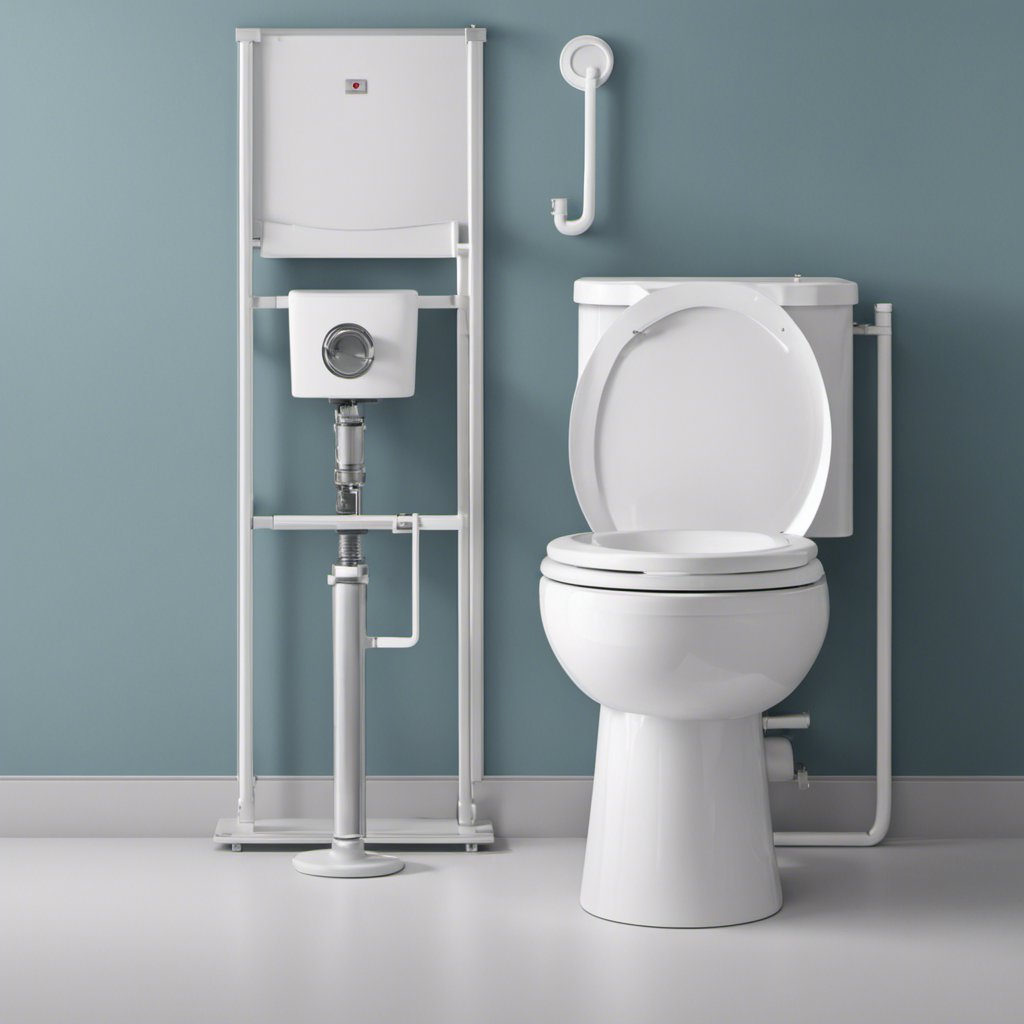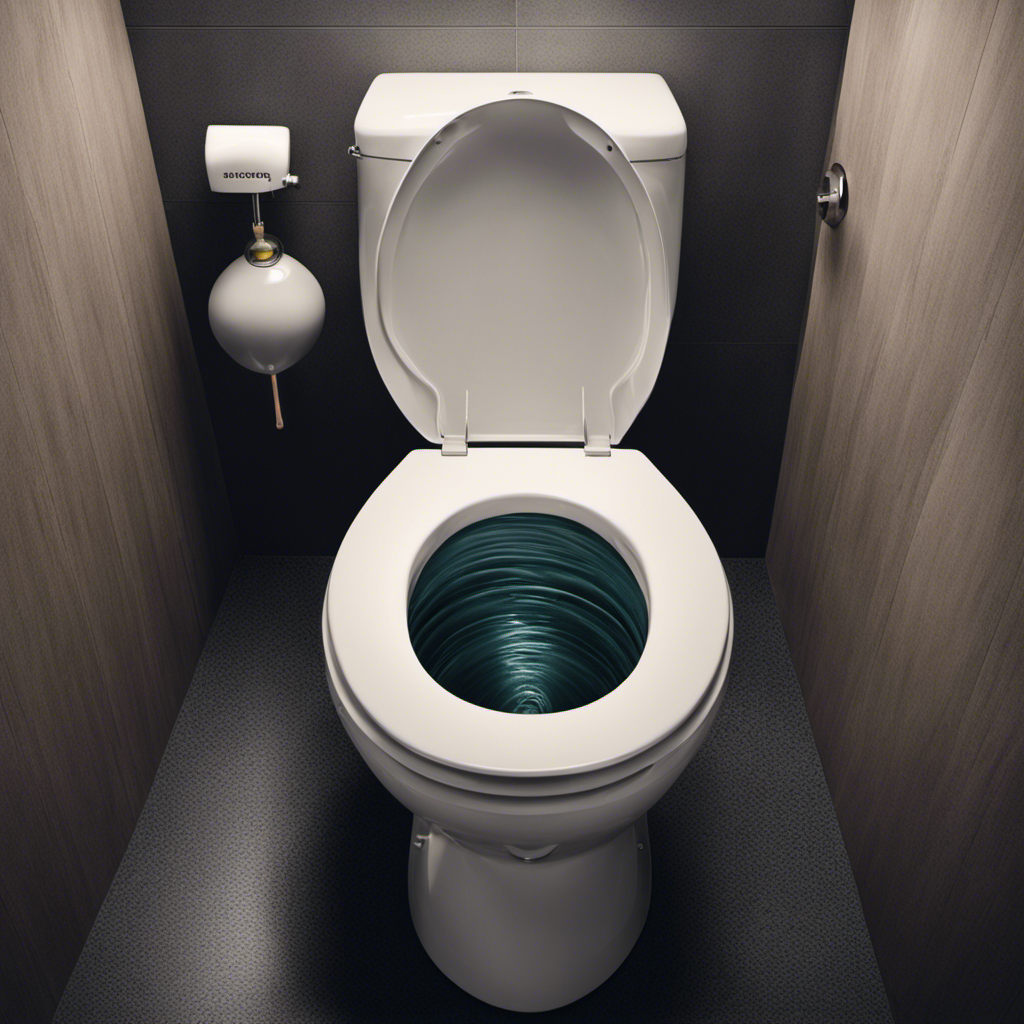Are you tired of dealing with clogged toilets and slow drainage? It’s time to put an end to your plumbing woes.
In this article, we will explore the importance of proper drain pipe sizing for your toilet. We’ll discuss the factors you need to consider when choosing the right size, as well as the step-by-step process to determine the correct drain pipe size for your specific toilet.
By using the correct drain pipe size, you can ensure efficient and trouble-free flushing every time.
Key Takeaways
- Proper drain pipe sizing is crucial for efficient flushing and preventing clogs.
- Factors to consider when choosing a drain pipe size include flush volume, distance to the main sewer line, and the number of connected toilets.
- The standard drain pipe size for a toilet is usually 3 or 4 inches in diameter, but checking the manufacturer’s specifications is crucial.
- The toilet drain size plays a crucial role in performance, and a small or large drain size can lead to plumbing issues and inefficiencies.
The Importance of Proper Drain Pipe Sizing
The importance of proper drain pipe sizing can’t be overstated. When it comes to toilets, it is crucial to follow a step-by-step guide for proper drain pipe sizing.
Using the wrong size can have serious consequences. If the drain pipe is too small, it can lead to clogs and blockages, causing backups and potential damage to your toilet and plumbing system.
On the other hand, if the drain pipe is too large, it can result in poor flushing and inefficient water flow. It is essential to consider factors such as the toilet’s flush volume, the distance between the toilet and the main sewer line, and the number of toilets connected to the same drain.
Factors to Consider When Choosing a Drain Pipe Size
When choosing a drain pipe size for your toilet, there are several factors to consider.
The size of the pipe will have a significant impact on the performance and functionality of your plumbing system.
Measuring techniques are crucial in determining the appropriate size.
The diameter of the drain pipe should be large enough to handle the volume of waste and water that the toilet will produce.
If the pipe is too small, it can lead to clogs and backups, causing inconvenience and potential damage to your plumbing system.
On the other hand, if the pipe is too large, it can result in inefficient flushing and wasted water.
It is essential to consult a professional plumber who can assess your specific needs and recommend the appropriate drain pipe size for your toilet.
This will ensure optimal performance and minimize the risk of plumbing issues.
Common Drain Pipe Sizes for Toilets
When it comes to selecting the optimal toilet drain size, there are a few key points to consider.
First, you need to ensure that the drain pipe is large enough to handle the amount of waste and water that will flow through it. This will prevent clogs and backups in the system.
Additionally, it is important to consider the compatibility of the drain pipe with the fixtures you plan to install. Different fixtures may require different drain pipe sizes, so it is crucial to choose one that is suitable for your specific needs.
Optimal Toilet Drain Size
To ensure proper drainage for your toilet, you’ll want to consider the optimal drain size. The toilet drain size specifications play a crucial role in the performance of your toilet. If the drain size is too small, it can lead to frequent clogging and slow flushing. On the other hand, if the drain size is too large, it can cause the water to drain too quickly, resulting in inadequate flushing and potential sewer gas leaks.
Here are five key factors to consider when determining the optimal drain size for your toilet:
-
Toilet fixture units (TFUs): This is a measure of the flow rate and drainage capacity of a toilet. It helps determine the appropriate drain size.
-
Pipe slope: The slope of the drain pipe affects the flow of waste and water. It needs to be at the right angle to ensure proper drainage.
-
Venting: Adequate venting is essential to prevent airlock and maintain proper water flow.
-
Local plumbing codes: Different regions have specific requirements for drain pipe sizes. Make sure to comply with the local plumbing codes.
-
Professional advice: Consult a plumber or plumbing engineer to assess your specific needs and ensure the optimal drain size for your toilet.
The impact of improper drain size on toilet performance cannot be overstated. It can lead to frequent clogs, inefficient flushes, and potential plumbing issues. By considering these factors and ensuring the optimal drain size, you can maintain the proper functioning of your toilet and avoid costly repairs in the future.
Compatibility With Fixtures
When choosing the components for your plumbing system, it is important to consider the compatibility of fixtures. Specifically, when it comes to toilet drain compatibility, you need to ensure that the drain pipe size is appropriate for the toilet you are installing. The drain pipe size should be able to effectively handle the waste and water flow from the toilet without any blockages or backups. The standard drain pipe size for a toilet is usually 3 or 4 inches in diameter. However, it is crucial to check the manufacturer’s specifications for the toilet you are installing, as some toilets may require a larger or smaller drain pipe size. Installing a toilet with the wrong drain pipe size can lead to plumbing issues and inefficiencies in the system. Therefore, it is essential to consider the drain pipe size when installing a new toilet to ensure proper compatibility and functionality.
How to Measure the Existing Drain Pipe Size
You can easily determine the size of the existing drain pipe by measuring its diameter with a tape measure. To ensure accuracy, follow these measuring techniques and avoid common mistakes:
- Use a tape measure: Measure the inside diameter of the drain pipe, not the outside.
- Measure at multiple points: Take measurements at different locations along the pipe to account for any variations.
- Round to the nearest inch: Round your measurements to the nearest inch for simplicity.
- Consider the material: Different materials can affect the flow capacity, so note the pipe’s material as well.
- Check for obstructions: Make sure the pipe is clear of any debris or blockages that could affect the measurement.
Steps to Determine the Correct Drain Pipe Size for Your Toilet
When determining the correct drain pipe size for your toilet, there are several factors to consider.
Firstly, pipe size calculation is crucial in ensuring proper drainage and preventing clogs.
Secondly, there are various factors that can affect the size of the pipe, such as the number of fixtures being connected and the distance the waste needs to travel.
Lastly, it is important to be familiar with the common pipe sizes used in residential plumbing to ensure compatibility and ease of installation.
Pipe Size Calculation
The first step in calculating the pipe size for a toilet is to determine the maximum flow rate. This is crucial for ensuring proper drainage and preventing clogs or backups. To accurately select the right pipe size, consider the following:
- Water consumption: Calculate the maximum flow rate based on the number of fixtures in your bathroom and their water usage.
- Pipe material: Different pipe materials have varying flow capacities, so choose a pipe size that can handle the expected flow rate.
- Pipe slope: The pipe should have a slight slope to allow for efficient drainage. Consider the available space and ensure the pipe can be installed with the proper slope.
- Ventilation: Proper ventilation is essential for maintaining optimal drainage. Ensure the pipe size allows for the necessary venting requirements.
- Code compliance: Check local building codes to ensure your pipe size selection meets the required standards for proper drainage.
Factors Affecting Size
Consider factors such as water consumption, pipe material, pipe slope, ventilation, and code compliance when determining the appropriate size for efficient drainage.
The pipe diameter is a crucial factor to consider. Plumbing regulations often dictate the minimum pipe diameter for toilet drainage. Typically, a 3-inch diameter pipe is recommended for efficient toilet drainage. This size allows for the smooth flow of waste and prevents clogging.
Additionally, the pipe material should be durable and resistant to corrosion. Common materials used for drain pipes include PVC (polyvinyl chloride) and ABS (acrylonitrile butadiene styrene).
The pipe slope is another key consideration. A proper slope ensures that waste flows smoothly towards the main sewer line.
Adequate ventilation is also important to prevent foul odors and maintain the integrity of the plumbing system.
Always check local plumbing regulations to ensure compliance with the appropriate standards for efficient drainage.
Common Pipe Sizes
You should know that common pipe sizes for efficient drainage are typically 3 inches in diameter. When it comes to choosing the right size drain pipe for your toilet, it’s important to consider both the minimum and maximum pipe diameter.
Here are some key points to keep in mind:
-
Minimum pipe diameter: The minimum pipe diameter refers to the smallest size pipe that can effectively handle the flow of wastewater from your toilet. It is crucial to ensure that the pipe diameter is adequate to prevent clogs and maintain proper drainage.
-
Maximum pipe diameter: On the other hand, the maximum pipe diameter refers to the largest size pipe that can still provide efficient drainage. Using a pipe that is too large can lead to slow drainage, as the water may not flow quickly enough to clear the waste effectively.
-
Proper sizing: It is essential to consult local plumbing codes or a professional plumber to determine the appropriate minimum and maximum pipe diameter for your specific toilet installation.
-
Pipe slope: The slope of the pipe also plays a role in ensuring efficient drainage. A proper slope allows gravity to assist in moving waste and water through the pipe.
-
Other factors: Apart from pipe diameter, other factors such as the toilet’s flush volume, the distance from the toilet to the main drain, and the number of fixtures connected to the same drainage system should also be considered when determining the appropriate pipe size.
Benefits of Using the Correct Drain Pipe Size for Your Toilet
Using the correct drain pipe size for your toilet offers numerous benefits.
One of the key considerations is the pipe diameter calculation. By ensuring the drain pipe is of the appropriate size, you can optimize the flow of wastewater and prevent any potential clogging issues.
When it comes to selecting the drain pipe size, opting for a larger diameter can be advantageous. This allows for a faster and smoother evacuation of waste, reducing the likelihood of blockages and backups.
Additionally, a larger drain pipe can handle a higher volume of water, which is especially beneficial in households with multiple bathrooms or high water usage.
Furthermore, a larger drain pipe provides improved ventilation, minimizing unpleasant odors and maintaining a more hygienic bathroom environment.
Overall, using a larger drain pipe size for your toilet can significantly enhance its performance and prevent costly plumbing problems.
Troubleshooting Common Issues With Drain Pipe Sizing for Toilets
When troubleshooting common issues with drain pipe sizing for toilets, it’s important to address any potential problems promptly.
Here are some solutions for drain pipe sizing issues that you may encounter:
-
Check the pipe diameter: Ensure that the drain pipe has the correct diameter to accommodate the toilet’s waste flow. If it’s too small, it can cause clogs and slow drainage.
-
Inspect the slope: The drain pipe should have a proper slope to allow proper waste flow. If the slope is too steep or too flat, it can lead to issues like blockages or incomplete flushing.
-
Check for obstructions: Look for any obstructions in the drain pipe, such as debris or tree roots. These can impede the flow and cause backups.
-
Consider venting: Proper venting is crucial for drain pipe sizing. Inadequate venting can lead to airlock issues and slow drainage.
-
Consult a professional: If you’re unsure about the drain pipe sizing or if the issues persist, it’s best to consult a professional plumber who can assess and resolve the problem accurately.
Conclusion
In conclusion, selecting the correct drain pipe size for your toilet is of utmost importance.
By considering factors such as the toilet’s flow rate, distance to the main sewer line, and the number of fixtures connected, you can ensure optimal performance and prevent potential issues like clogs and backups.
By taking the time to measure and determine the appropriate drain pipe size, you can enjoy the benefits of a properly functioning toilet system.
Don’t let improper drain pipe sizing flush away your peace of mind – take the necessary steps for a smooth and efficient plumbing experience.










